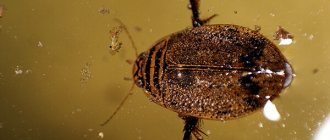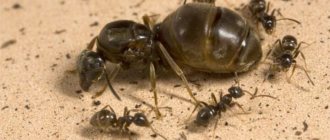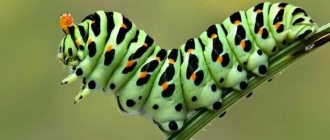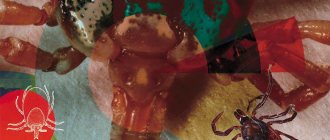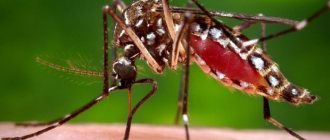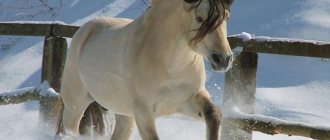Description of the swimmer and its specifics
The swimming beetle spends the vast majority of its time in the aquatic environment. In order to ensure ease of movement, nature gave him a streamlined body that allows him to move dynamically with minimal resistance.
The average size of an adult insect is about 5 cm. The color range includes shades from brown to black.
In the photo of the diving beetle you can see that its body consists of an abdomen, a thorax and a head. The insect has 6 legs. The two front pairs are designed to be attached to plants.
They are equipped with hooks that provide a secure fit. The beetle is an excellent swimmer, since its hind legs serve as oars and help the beetle develop solid speed when moving in the water.
The wings of the diving beetle are well developed. But the insect rarely uses them, since it spends most of its life in water. Beetles fly only when it is necessary to look for a new place of residence due to the drying up of a reservoir, or in search of food.
Insects are excellent at navigating the aquatic environment. They are helped in this by their unusual eyes, consisting of several thousand small facets.
Swimming beetles have powerful, sharp jaws that allow them to eat live prey.
Most of the swimmer's life is spent in the underwater environment, but it needs a regular supply of oxygen. Every 15 minutes he has to float to the surface for a new portion of air.
The pores through which oxygen enters are located on the abdomen, the insect turns over on its back, receives the necessary dose of air, and is again immersed in water.
Replenishing your oxygen supply is required for more than just breathing. The beetle's body has a special sac that contains air. It is needed for the processes of diving and ascent.
| Lifespan | 1-2 years |
| Basic food | Insects fish fry small fish tadpoles and frogs |
| Main Enemies | large fish mammals living near water birds insect rider |
How to get rid of a swimming beetle?
This insect cannot be controlled with chemicals. Chlorination of water is also completely useless. If the population is small and there is no vegetation in the pond or pool, you can try catching the beetles by hand. But the effectiveness of this method is also relative. To get rid of a diving beetle, it is necessary to eliminate the cause of its appearance or create unfavorable conditions.
There are three most popular methods of struggle:
- Complete drainage of water. It is important to ensure there are no insects before refilling. Larvae and pupae may remain in the soil. All plants that were in the pond should be removed.
- Create a water cycle. The arthropod only loves standing water. The easiest way to create a whirlpool is a fountain. All adult swimmers under such conditions will immediately go in search of a more favorable habitat.
- Introduce natural enemies into the pond. The greatest threat to the beetle is crucian carp. The fish feeds on both adults and larvae. Swimming beetle larvae are the basis of the diet of crucian carp in nature.
During temporary relocation, the entire fish population must be inspected for the presence of pests. Before releasing fish into a cleaned pond, they should be quarantined to ensure that the insects do not return to their old place of residence. When the pool is completely drained, it is recommended to lime the bottom for greater efficiency.
Main types of diving beetles
The diving beetle family includes more than 600 species. In order to know what swimming beetles look like, you need to know the characteristics of the varieties. Several representatives live in the middle zone:
Banded swimmer dytiscus marginalis
This type is the most common. It got its name because of the ocher border that frames the body. Populations of these aquatic insects are found in American and Japanese reservoirs, water areas of European countries, and in the Yakut region. The size of an adult beetle is about three centimeters.
Latissimus or broad swimmer dytiscus latissimus
These are the largest representatives of swimming swimmers. Their length can exceed 4 centimeters. Only clean water is suitable for these individuals to live.
Pollution of water bodies with products of human activity and environmental deterioration have led to a sharp reduction in their numbers.
In several countries, the insect is listed in the Red Book.
Sulcata acilius sulcatus
This beetle's favorite food is tadpoles. This determines habitats. Insects settle in reservoirs with stagnant water, in which frogs and small fish are found.
An adult beetle grows up to one and a half centimeters. Populations of stripers exist in Russian waters, North African regions, and East Asian countries.
Pond snail colymbetinae
Pond snails live in overgrown, abandoned ponds. The color of the insects is dirty brown; the wings have a pattern of transverse relief.
Ilnik rhantus
This family includes more than 100 species. Ilnik is not large in size, reaching a length of about 1 cm.
These insects differ from their counterparts in color. There are yellow-bellied and black-bellied eelgrass. The wings are red or yellow, covered with black dots.
Ilnik prefers swampy bodies of water.
Popular representatives of the diving beetles include flat and marsh divers. Like elnik, they are small in size. Adults reach 5 mm. These insects are found in lakes and slow-flowing rivers.
Reproduction of swimming beetles and life expectancy
The mating period begins in the spring. Males have suckers on their front legs, allowing them to firmly attach themselves to the female. The process can last up to 48 hours.
During this time, only the male whose abdomen is above the water can carry out high-quality air intake. If a female has had several matings in a row, she dies from lack of oxygen.
After the process, the female immediately seeks shelter, as the males can use her as easy prey. It lays larval eggs on the leaves and stems of plants, secreting a special sticky substance to firmly attach them.
For the most part, beetles are used for laying:
- cattail
- iris
- marigold
- calligraphy
- arrowhead
The duration of the egg development period depends on the water temperature; it can last 8-40 days. After molting, the emerging larvae move to land and bury themselves in soft soil for pupation.
The insect remains in this stage for about two months, after which an adult emerges from the pupa. She sits in her hole for several days so that the covers completely harden, then she leaves it and goes to the water.
How long the swimming beetle lives depends on various conditions. On average, life expectancy is 1-2 years.
At home, a pet can live up to 3 years.
Some interesting facts
These insects are dangerous predators. But floating insects do not show aggression towards people.
If you try to catch a beetle and pick it up, it may bite.
This causes severe pain that goes away gradually. Swelling appears in the bite area, which can last up to 3 weeks.
It is necessary to immediately wash the wound and apply a disinfectant. You need to apply a cold object to the skin, then apply a bandage.
These insects may consider ornamental fish their prey and injure them. Therefore, these pets cannot be kept in the same aquarium.
Why is the swimming beetle dangerous?
The insect can pose a serious threat to small ponds. The beetle destroys the populations of most aquatic inhabitants. Decorative fish are also attacked by it. The pest often settles in fish farms, destroying all the fry. In addition, it can harm aquarium fish.
Is the swimming beetle dangerous to humans?
The beetle is capable of biting through the skin, but given the absence of toxic substances, its bite does not cause an allergic reaction or poisoning. However, such a wound causes severe acute pain that can persist for a long time. After a bite, swelling and hyperemia often appear. Symptoms go away on their own after 2-3 weeks.
It is important to consider that the bite site must be treated with an antiseptic. Otherwise, there is a high risk of boil formation. When an infection occurs, the redness of the skin often increases.
Lifestyle Features
The swimming beetle is a tireless and insatiable predator. He rests only while taking air. The rest of the time is devoted to searching for prey and hunting.
If the reservoir becomes shallow and there is no food in it, the insect has to look for another place to live. To do this, he needs to make a flight, for which the beetle climbs ashore.
On land, it moves slowly, alternately moving its legs, but diving beetles fly well, in which their developed wings help them.
The swimmers are awake around the clock. But at night, visual acuity decreases noticeably. It is at this time that they usually have to fly in search of new places to live.
For insects, this is a risky maneuver, since a flying beetle can mistake a shiny, hard surface for water. He dives at her and dies.
In the swimming beetle community, relationships are brutal. Individuals fight for territory, beat, bite less powerful relatives.
Males may attack a female who is weakened after mating, considering her easy prey.
Breath
The insect's body receives oxygen when it ascends to the surface. The pores through which air enters are connected to the trachea, which ensures the supply of oxygen to all parts of the body.
Hibernation
Before the onset of cold weather, swimming beetles set up a cozy burrow for wintering. They sleep in it until spring.
Diet
It is believed that the diving beetle is the most terrible beetle in fresh water bodies. These predatory insects are indiscriminate eaters.
The beetle's diet is varied. Swimming beetles feed on tadpoles, insects, fry, and small fish. They are insatiable, constantly feeling hungry.
If there is no suitable food, the swimmer's prey can be a fish, newt or frog that is several times its size. He alone cannot cope with such a victim, then the swimmer injures her. At the smell of blood, many relatives gather and eat the prey alive, tearing off pieces from it.
In the photo of the diving beetle you can see powerful jaws that allow it to cope with such prey.
The greatest danger is posed by the larvae of the diving beetle. They also have powerful jaws with which they bite into the body of prey to inject a toxic substance into the bloodstream, paralyzing the victim.
After this, the larva introduces another enzyme into it, under the influence of which the tissues turn into a jelly-like state. Now the hunter can absorb the substance.
The larvae have an immoderate appetite; they feed almost constantly.
Reproduction and life cycle
Swimming beetles belong to the genus Coleoptera and are oviparous. During the mating period, the male injects sperm that are sufficient for several months of egg laying. They are quite large in size and can be seen on the leaves, stems of reeds, irises, and other plants.
After maturation, the larvae leave the eggs and begin an independent life until molting. The next stage is pupation, which takes place on the shore in soft soil.
The adult, emerging from the pupa, moves into the aquatic environment after the integument hardens. In nature, the lifespan of a diving beetle is 1-2 years.
Lifestyle of a swimming beetle
The arthropod moves quite quickly on land, swims well and can fly. The swimmer has a light body, so it is easier for it to float to the surface than to dive into the water. To stay at the bottom, he needs to cling to a plant or stone. For this purpose, the beetle has special hooks on its forelimbs.
The swimming beetle is quite aggressive, including towards its own kind. Usually hunts alone, but when there is a shortage of food, the beetles gather in groups to attack larger prey.
The hind limbs are used only during swimming, and also for pushing off on land. The limbs located in the center help change the direction of movement and hold prey. The first pair of limbs plays a huge role in capturing prey and moving on land. When hunting, arthropods primarily rely on the organs of touch, i.e. antennae. The eyes play a secondary role and help accurately determine the location of prey.
Breath
The swimmer cannot breathe underwater. That's why it pops up every 8-10 minutes. The spiracles, through which oxygen enters the body, are located on the abdomen. Therefore, when emerging, the beetle exposes only the back part of its body from the water. Tracheas are located throughout the insect's body.
There are air sacs on the chest compartment of the pest. The larvae also have similar ones. However, the function of spiracles in young individuals is performed by thread-like appendages located on the back of the body.
Wintering
The swimming beetle overwinters at all stages except the pupa. The behavior of species of this family when unfavorable conditions occur is different. Most varieties come to the surface by burrowing into the bark or soil. Some representatives hide in the mud. Most often, insects overwinter at the imago stage.
What does the swimming beetle eat?
The swimmer is extremely unpretentious. The swimming beetle can feed on insects, fish, and amphibians such as frogs and newts. The main prey for these beetles are fry and tadpoles. Adults may bite off large prey and retreat, waiting for the next opportunity to attack. Beetles attack prey that is 3 times their size.
The larvae do not have a mouthparts. Feeding occurs by injecting gastric juice into the victim’s body, it liquefies the victim’s internal organs, after which the larva absorbs them.
Reproduction and life cycle
An insect has a complete metamorphosis, that is, it goes through the stages of egg, larva, pupa and adult.
Mating occurs in the spring, in water. Males catch females and attach themselves to them using suction cups located on their forelimbs. Mating can last up to 2 days. At the same time, only males can breathe. Females, by the end of mating, are in a severely exhausted state and cannot swim on their own. Therefore, the males help them rise to the surface. If the mating process was interrupted or the female has several matings in a row, then there is a high risk of her death.
After mating, females hide in vegetation or mud. This is justified by the fact that males often attack a weakened relative immediately after mating, seeing him as easy prey. The resulting sperm are sufficient for 8 months of egg fertilization.
The female lays eggs on the stems and leaves of some plants. Certain species can lay eggs in the soil. Being in the plant tissue, the eggs are protected from many predators. In this case, the masonry is firmly attached to the plant due to the release of a special sticky liquid. Most often, the diving beetle lays eggs in the following plants:
- marigold;
- arrowhead;
- calliper;
- iris;
- reed;
- Elodea;
- chastukha;
- pondweed
The eggs are laid individually, but can also be on the same leaf or stem. Once in the water, the egg stops developing. The masonry is clearly visible in the leaves, because it can be seen right through there. At the site where the female beetle laid an egg, you can see a brown spot or stripe.
The egg develops from 8 to 40 days, depending on environmental conditions. The most favorable temperature is 28 °C. The eggs of this insect are often parasitized by wasps.
The eggs are large, up to 6-7 mm long. Most often they have an oval shape. The color is predominantly light yellow. The shell is very thin, so the shape of the eggs may be slightly distorted.
The emerging swimming beetle larva is constantly in ambush. Having finished molting, she climbs ashore and buries herself in the soft soil. It is almost impossible to detect it.
The larvae have a massive body with a large number of segments. The head is large and flat. The jaws are well developed. At this stage, the swimming beetle larva has three pairs of limbs, all of which are used for swimming. The color of the larvae is always lighter than that of the imago. The color ranges from sand to red. There may be dark spots. During the molting process, the size of the arthropod changes noticeably. By the end of the larval stage of development, the body length of the larva usually exceeds the size of the parent. In total, the diving beetle larva changes through three instars.
Pupation takes several weeks. The beetle pupa looks like an adult. At this stage, the arthropod is distinguished by a light yellow uniform color. Over time, her legs darken and turn brown. The type of pupa is open.
Natural enemies of insects
The waterfowl beetle has many natural enemies. They may fall victim to:
- big fish
- mammals living in water
- seagulls, other birds
For the larvae, the main enemy is the rider. The females of these insects easily find victims by their special smell. They lay eggs in the bodies of the larvae, where they undergo the processes of feeding and pupation. This leads to the death of the diving beetle larvae.
To protect themselves from enemies, nature gave the swimmers powerful weapons. In a dangerous situation, the beetle secretes a white secretion that has a pungent, unpleasant odor. It scares away hunters and saves the insect's life.
